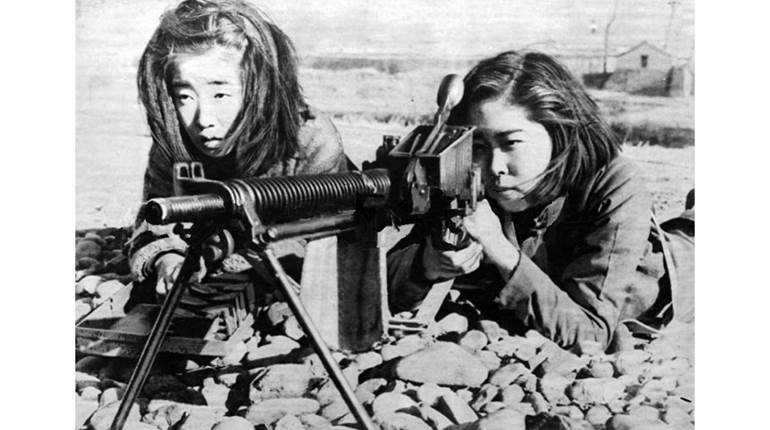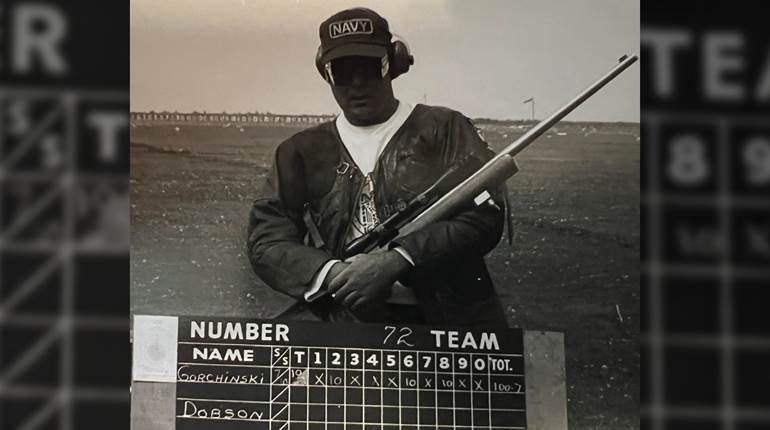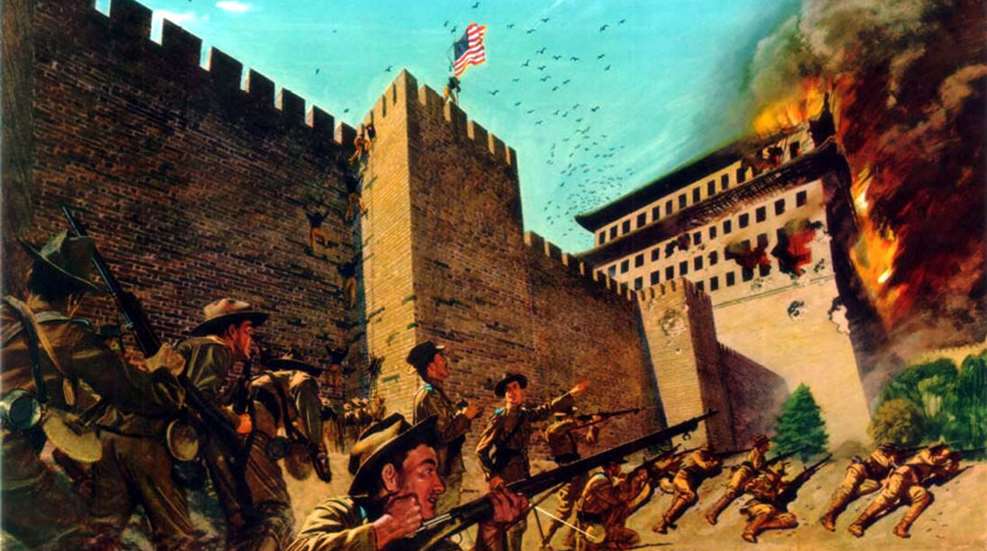
Above: The official U.S. Army painting of the 14th Infantry Regiment’s assault on the Tartar Wall at Peking, Aug. 14, 1900. Corporal Calvin P. Titus scaled the wall near the Tung Pien Gate, raised the American flag and laid down a suppressing fire that allowed more troops to follow him. For his actions, Titus was awarded the Medal of Honor.
A Violent Revolution in China
After victory in the Spanish-American War, the United States found itself in possession of the Philippines, which put American interests on the doorstep of China, even then a hotbed of international trade and intrigue. The Philippine Islands offered an important staging area for American trade and political interaction with the Manchu Empire. By the end of the 19th century, China struggled with a de facto partitioning of its territory by the Great Powers. In September 1899, the United States secured agreement from the European powers to enable an “Open Door Policy” for multi-national relations with China.
All of this foreign intervention did not sit well with many Chinese, and quickly led to the development of a revolutionary group, called “Boxers” by westerners and the Righteous Harmony Society by the Chinese. By early 1900, the Boxers had driven much of China to the brink of revolution. In northern China, christian Chinese and many Western missionaries were attacked and sadly, hundreds were killed. When the German ambassador to China was assassinated in June, the Chinese government severed diplomatic relations with western nations and demanded that all foreigners leave immediately. Thus began what is commonly known as “The Boxer Rebellion.”
The International Legation
Despite the orders of the Chinese government, and offers of “safe passage,” more than 3,000 Westerners and Chinese christians refused to leave. They gathered together and took refuge in the foreign legation compound in Peking. A military force of approximately 400 men (including about 50 Americans) supported by some Western civilians was raised to defend the compound. A large force of Boxers assembled outside the walls and the siege began. The outlook for the trapped legation appeared grim.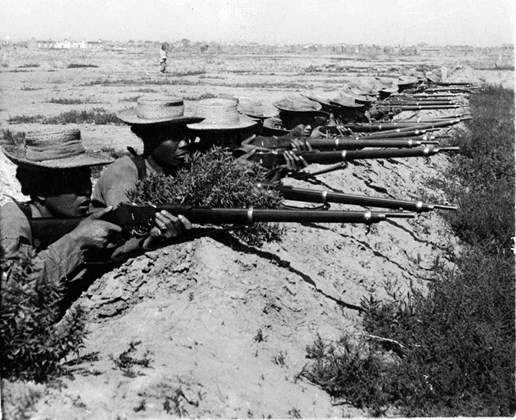
Blocking the road to Peking, Chinese troops at Tientsin armed with Martini-Henry breech-loading rifles.
The China Relief Force
Following the death of the German ambassador, the Great Powers quickly began to organize a military expedition to rescue the Westerners trapped in Peking. With significant forces already based in the Philippines, America joined in the expedition. Despite a national preference for isolationism, the United States was pulled into global intervention to protect its citizens and interests abroad.
An early international relief force (including more than 100 Americans), called the Seymour Expedition, attempted to reach Peking in June, but was blocked at the port of Tientsin.
The first American troops left the Philippines on June 14, 1900, as a small detachment of the 1st Marine Infantry Regiment sailed for Taku. After landing, they pushed on towards Tientsin.
The US Army’s 9th Infantry Regiment, commanded by Col. Emerson Liscum, left Manila on June 27, arrived at Taku and then marched on Tientsin. By July 13, an international force was assembled and Tientsin was assaulted. The U.S. 9th Infantry bore the brunt of the fighting, suffering more than 10 percent casualties, including the loss of Col. Liscum. Their sacrifice had opened the route to Peking.
By August, American forces were designated as the “China Relief Expedition” and had grown to include the 14th Infantry Regiment, a battery of the 5th Artillery Regiment, and the 6th Cavalry Regiment. Major General Adna Chaffee was placed in overall command of more than 2,500 U.S. soldiers, sailors and Marines.
The Battle of Peking
By early August, a multinational military coalition called the “Eight-Nation Alliance”, marched from Tientsin to Peking. The Allied force was made up of about 18,000 soldiers (4,300 Russian infantry, Cossacks and artillery; 8,000 Japanese infantry; 3,000 British, mostly Indian infantry, cavalry and artillery; 2,500 U.S. soldiers and Marines with artillery; and an 800-man French (Indochina) brigade with artillery. Germany contributed a force of infantry and cavalry, while Austria and Italy provided small numbers of men for the operation.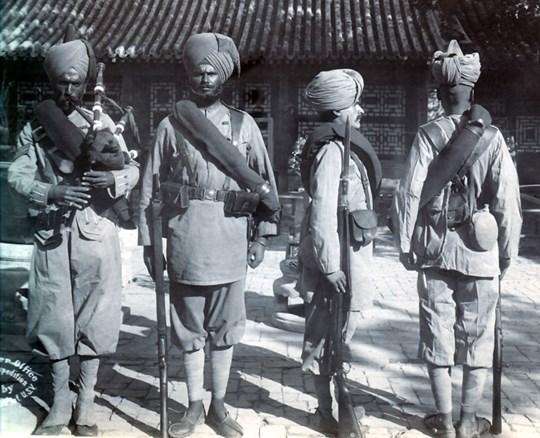
Most of the British contingent was comprised of Indian troops. These men, from the 24th Punjabs, carry the .303 caliber, Rifle, Magazine, Lee-Enfield which was adopted in late 1895.
Along the way, American troops fought at Pei-tsang, and along with the British contingent were engaged in heavy fighting at Yang-tsun in early August. The combined relief force reached the outskirts of Peking on Aug. 12, 1900. On Aug. 14, troops of the U.S. 14th Infantry Regiment scaled the Tartar Wall and raised Old Glory on the battlements, the first time a foreign flag had ever flown on the Chinese capitol. Shortly afterward, British troops broke through to the trapped foreign legation compound. The next day, the U.S. 5th Artillery blasted open the gates to the Inner City, and Allied troops poured in to occupy Peking city center.
Chinese Aftermath
After a few months of “mopping up” operations against the Boxers, the Eight-Nation Alliance offered peace terms to China’s Dowager Empress. These terms reaffirmed international trade concessions along with significant reparation payments to Allied nations. An international army of occupation remained in place until 1901, and an international garrison was to remain in place at the fortified International Legation in Peking. An American military contingent remained on duty at the International Legation in Peking until 1938. Interestingly, the United States was to receive reparations of $333 million, but only $25 million was ever collected, and then $17 million of that sum was returned to China to be used in a fund for the education of Chinese children.
The American Arsenal
American troops went into battle in China carrying many of the arms they had used in their recent war with Spain. The primary American infantry rifles were both recently acquired and simultaneously destined to remain in U.S. service for just a short time.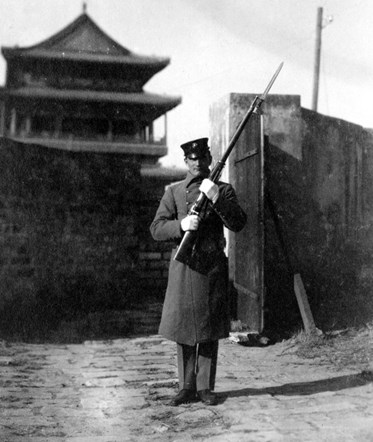
A new world power: A U.S. sentry stands guard at Peking with a Krag-Jorgensen rifle.
In the China Expedition, the U.S. infantry carried the Krag–Jørgensen rifle, Model of 1896, while the small U.S. cavalry contingent carried the Krag Model of 1896 carbine. Both were chambered for the “Cartridge, Caliber 30, U.S. Army” (often called the “.30 Army,” we know it today as .30-40 Krag). The Krags had performed well in the Spanish-American War, and, ultimately, they were well-regarded for their service in China.
Meanwhile, the U.S. Marines in China carried the Lee Navy Rifle, Model of 1895, chambered in 6 mm or .236 Lee Navy. The China Expedition represented one of the few times that the M1895 Lee Navy rifles saw action during their short service life. While there were some concerns about the Lee Navy’s straight-pull, cam-action design, their service in China was without complaint. The Marine Legation Guard carried the Lee Navy Rifle in their defense of the foreign legations compound in Peking. The first relief force (the Seymour expedition) brought approximately 10,000 rounds of .236 ammunition, and this kept the Marines flush with this less-common ammunition throughout the action in China. Marine marksmen reportedly used their Lee Navy rifles with deadly effect during the Expedition, silencing Chinese snipers and artillery crews with accurate long-range fire.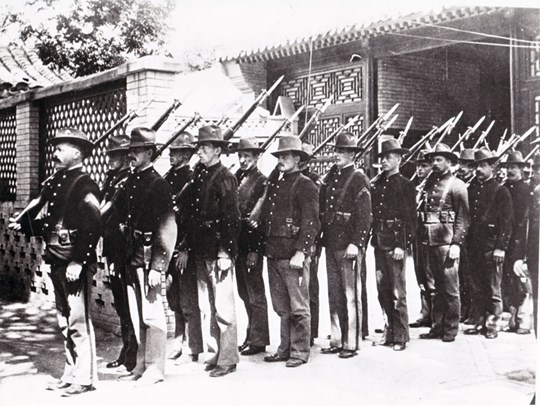
China Marines: A U.S. Marine Corps detachment armed with 6 mm M1895 Lee Navy rifles.
American automatic or rapid-fire arms were used in China, albeit in small numbers, and were generally considered to be a part of the artillery. There were at least three Model 1895 Colt-Browning machine guns in 6 mm Lee Navy available during the attack on Tientsin.
In his book America in the China Relief Expedition, (Hudson-Kimberly Publishing Co., 1908), Brig. Gen. A.S. Daggett, U.S. Army, comments on the American arms he witnessed in action in China.
As a Russian commander commanded a premature assault on Tientsin, likewise demanding that a small American advance force join in the attack: “Captain Wise and Major Waller succeeded in making up a train to move the latter's troops, with one 3-inch gun and one Colt's automatic gun, 6 millimeter.”
The Americans advanced along with a Russian infantry, who were quickly ambushed and put to flight, leaving the U.S. troops to cover their retreat.Daggett remembers: “The strength of the enemy was estimated to be from 1,500 to 2,000 Boxers and Imperial troops. The Colt gun, with some assistance, kept the frontal fire down, while the Americans and some Russians changed front to right and rear, to meet the annoying flank fire. Soon after this the Russians withdrew from the front and formed about a half mile to the right of the Americans, thus exposing the left of the latter to a severe fire. The Colt gun, having jammed several times, and only Lieutenant Powell and one man left to man it, was disabled and abandoned.”
“The Americans covered the retreat of the Russians, receiving no assistance from them whatsoever. This little band of 123 men, now reduced by casualties to a little more than 100, successfully resisted the pursuing enemy who, had they been braver and more energetic, should have overwhelmed these stubborn fighters. It was here, as at Santiago and other places, that the skill of the riflemen saved us from disaster, or gave us victory.”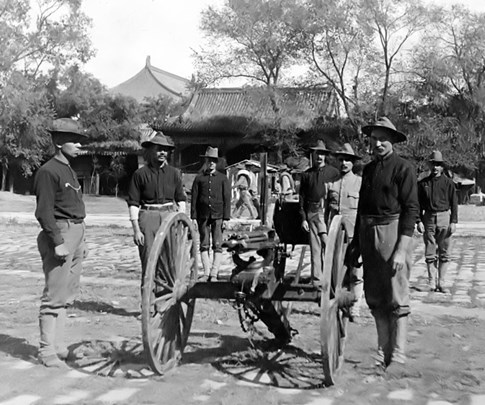
American troops with a Model 1895 (10-barrel) Gatling gun. Chambered in “.30 Army,” this gun could fire more than 700 rounds per minute.
As in the war against Spain, the more established and familiar Gatling Guns (chambered in “.30 Army”) were widely praised and considered effective. General Daggett observed a Gatling Gun in action during the attack on the walled city of Peking. “Lieutenant Corcoran, with his Gatling Gun, also came into action at this time, directing his fire through the left archway. He did good work.”
General Daggett went on to praise America's extensive rifle training programs for creating a culture of marksmanship: “The wisdom of the Government in maintaining a system of target practice for many years, was more than justified ... . Under judicious rules, there should be no limit to the expenditure of ammunition on the target range. A nation whose army is largely composed of marksmen and sharpshooters will be a victorious nation.”
The Krag-Jorgensen carbine was in use with the US cavalry. General Daggett observed: “Captain Cabell's troop of cavalry followed the artillery into the Tartar City and halted before the first gate of the Imperial City. Observing some snipers in trees to the right of the Chinese position, the Captain took five men, opened fire on them, and silenced their fire. The Captain dropped two Chinamen from the trees with his carbine.”
Facing the Americans in China, the Boxers were equipped with a wide variety of armament ranging from the ancient and traditional to the relatively modern. According to Capt. A.P. Blocksom, Sixth Cavalry, “One-third of the Chinese enemy are armed with rifles, the remainder carrying spears, swords, etc.”
"Also, some large ‘Jingals’ were mounted on wheelbarrows and rickshaws ..."
Reported 6th Cavalry Lt. Col. Theo J. Wint. The “Jingal” that Lt. Col. Wint mentions is a massive .60-cal., or sometimes even .75-cal., single-shot, bolt-action wall gun. Exceptionally long and cumbersome, the Jingal guns were nonetheless described as effective arms with great range.
The Dawning of a New Era
Today, the achievements of the multinational Peking Expedition are barely remembered and rarely discussed. Few American schools even make mention of it. Still, the ability of the Eight-Nation Alliance to deploy forces for a joint mission in a distant nation is rather impressive, even by contemporary standards. In fact, the China Relief Expedition, conceived and executed long before the modern United Nations was even a concept, stands in stark contrast to the foot-dragging ineptitude and impotence of any modern multinational force. America was coming of age, and becoming an undeniable world power.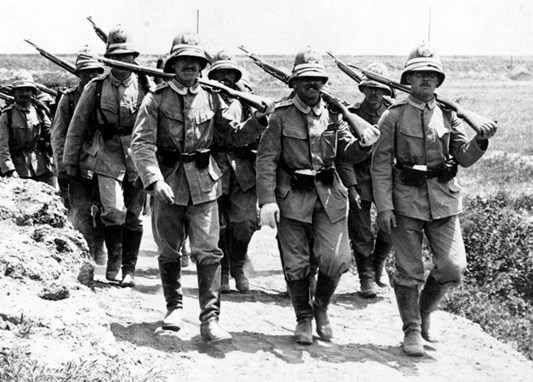
German troops outside Peking. They carry the early version of the famous Mauser Gewehr 98 rifles (chambered in 8x57 mm Mauser). The China Expedition was the first combat action for the Mauser rifle.
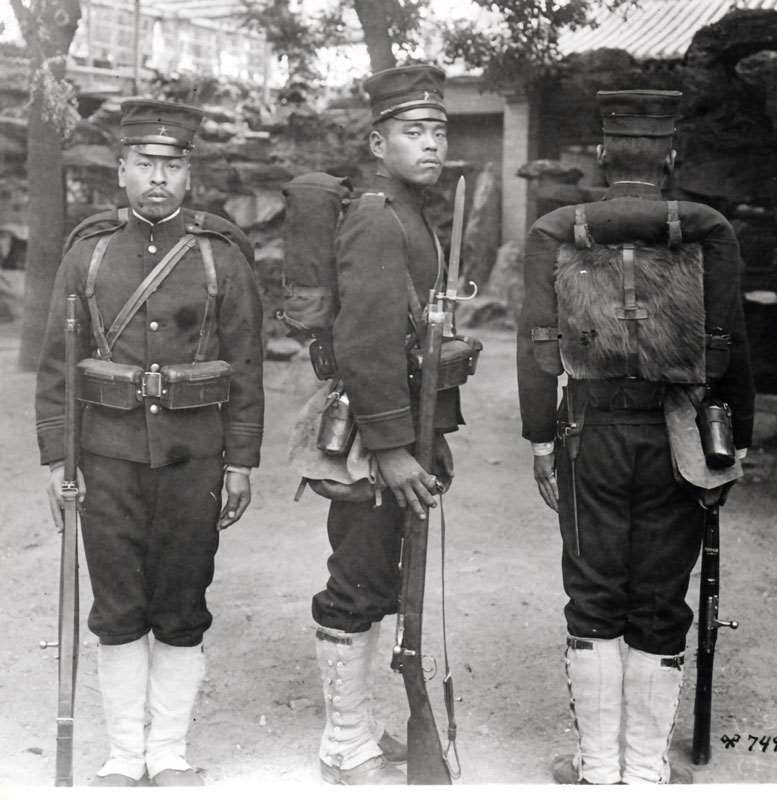
Firearms enthusiasts note that the Expedition also ushered in a new era of firearms, particularly infantry rifles. English (Lee-Enfield), German (Mauser Gewehr 98), French (Lebel 1886) and Russian (Mosin-Nagant M1891) troops all went into action in China with the battle rifles that would see them through World War I. American troops with the Krag-Jorgensen, and Japanese troops with their Type 22 Murata, would soon upgrade their standard infantry rifles. The brilliance of the M1903 Springfield rifle was just a few years away. In the meantime, the exploits of American riflemen, and our national culture of marksmanship, had already captured the attention of friend and foe alike, all over the world.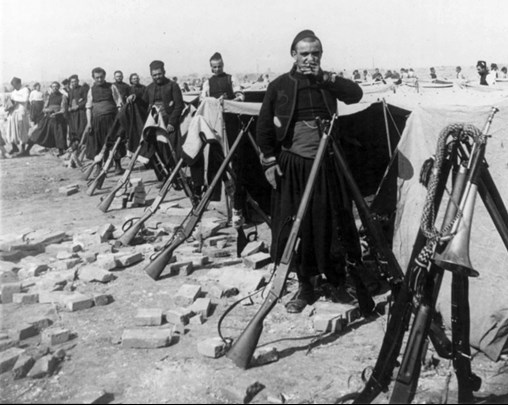
French Zouaves of the Peking Relief Expedition. These men are seen outside Tientsin and are armed with the Lebel Model 1886 chambered in 8x50 mm R Lebel.












